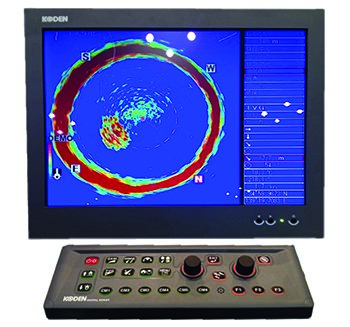If you think it’s time to replace the machine in your wheelhouse that’s supposed to find and keep track of fish lurking beneath your boat then you need to check out “Finding Keepers.” That’s a roundup of some of the newest sonar and sounder machines in National Fisherman’s July issue. The story begins on page 30.
Koden’s KDS6000BB sonar is billed as the industry's first broadband searchlight sonar.It starts off with Furuno’s FCV-1900 series sounders, which come as both black box and stand-alone units. Some of the features include scroll back, which allows past echo displays to be reviewed and the simultaneous display of two gain settings.
The FCV-1900G, a stand-alone sounder, comes with Furuno’s TruEcho CHIRP and a fish size indicator. This gives precise estimations of fish size and the distribution of fish in a school by size.
Another sounder is Simrad’s ES80, a split-beam echo sounder with a frequency range of 10 to 500 kHz. The ES80 can have CHIRP capability and sweep a range of frequencies. It might be the only sounder combining both CHIRP and a split beam.
Another first would be Koden’s KDS6000BB sonar. It’s billed as the world’s first broadband searchlight sonar. It uses a wideband transducer letting you to select a range of frequencies between 130 and 210 kHz. And the frequencies can be changed in 0.1 increments.
Simrad’s FM90 trawl sonar is a third-wire system that puts a new view of the trawl opening on your screen every one to three seconds. Information from Simrad’s wireless sensors on the trawl and doors can be digitally transmitted to the headrope mounted FM90 and then sent on to the wheelhouse.
A new dual-beam sonar that’s just been put on some West Coast shrimpers and Alaska pollock boats is Wesmar’s HD860. For a shrimper, the wide beam allows you to bottom type the sea floor in front of the trawl and steer to where the shrimp are. In the Bering Sea the HD860 has been successful at detecting pollock on the bottom.
Marport’s Speed Explorer SPE 155-W is a headrope-mounted sensor that combines the functions of a trawl eye and a trawl speed sensor. Among other things, it tells if the trawl is being towed at the right angle and condition of the trawl in relation to the sea floor and the surface. Information on water flow across the trawl and along direction of the two are upgraded every three seconds.
Anyway, these are just some teasers. You best turn to “Finding Keepers” to learn more about the latest fishfinding machines.







